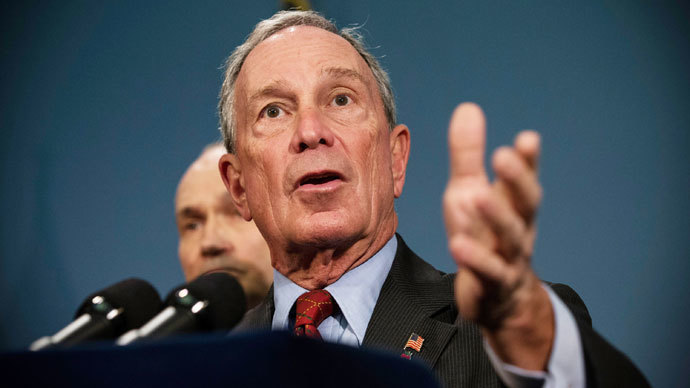Mayor Bloomberg trashes New York judge’s stop-and-frisk curbs

New York Mayor Michael Bloomberg has said that a federal judge’s decision to reform the NYPD’s stop-and-frisk policy could mean a return to the days of violent crime, which has plummeted since Bloomberg took office 12 years ago.
Bloomberg warned that Monday’s decision by US District Judge Shira Scheindlin would jeopardize New York’s tenure as “America’s safest big city.” He said he would appeal the ruling, but he likely won’t be in office to see the results as his third and final term ends this year.
“This is a dangerous decision made by a judge who I think does not understand how policing works and what is compliant with the US Constitution as determined by the Supreme Court,” Bloomberg said. “I worry for my kids, and I worry for your kids. I worry for you and I worry for me. Crime can come back any time the criminals think they can get away with things.”
He warned that the ruling could see a return to the days of mayhem and rampant crime in the 1990s before his predecessor, Mayor Rudy Giuliani, took office. Murders in the city hit an all-time high in 1990 at 2,245, but by 2012 the murder rate had fallen to an all-time low of 418.
Judge Scheindlin ruled that police have intentionally and systematically violated the civil rights of tens of thousands of New Yorkers by mainly targeting black and Hispanic men.
The judge has also appointed an outside independent monitor to oversee major changes in police tactics, a reform in policies and training and supervision of officers. She has also ordered a pilot program to test body cameras, which will be worn by police in the areas of the city where most checks occurred.
“The city officials have turned a blind eye to the evidence that officers are conducting stops in a racially discriminatory manner,” Scheindlin said. In their zeal to defend a policy that they believe to be effective, they have willfully ignored overwhelming proof that the policy of targetingthe right people’ is racially discriminatory,” she said.
Scheindlin said she wasn’t putting an end to the practice, but merely trying to reform the way the NYPD carried it out.
But Mayor Bloomberg emphasized that the police have focused their efforts at keeping black and Hispanic minorities safe, as they are disproportionally the victims as well as the perpetrators of crime.
He said the police had done what they had to do to keep the city safe, and that they were using the one tool that has helped drive down crime rates, which was within the Constitution and backed up by the courts.
Police Commissioner Ray Kelly also called the allegations of racial profiling “recklessly untrue” and noted that the NYPD is “the most ethnically and racially diverse police department in the world.”
Judge Scheindlin refused to hear evidence of crime rates in New York, which made things more difficult for the city’s defense team.
NYPD crime statistics based on race for 2012 show that there were significantly more black and Hispanic suspects, arrestees and victims of crime across all areas of crime.
The stop-and-frisk policy has been used by police for decades, but recorded stops hit an all-time high of 684,330 in 2011, and most of those stopped were either black or Hispanic.
About half those stopped by police are only questioned, while others have their bags searched and in some cases officers carry out a full pat-down body search. Only 10 percent of all stops result in arrest, and a weapon is found only a fraction of the time.
In her lengthy ruling, Judge Scheindlin said that at least 200,000 stops were in her opinion made without sufficient grounds for suspicion, and that rank and file officers were often pressurized by their superiors to make stops, while police commanders ignored evidence that stops were repeatedly being made against the wrong people.
The lawsuit was originally filed in 2004, by four ethnic minority men and evolved into a class-action case. Judge Scheindlin presided over a 10-week trial that included evidence from 12 people who had said they had been stopped only because of their race. Of 19 stops discussed in court, she found that nine were unlawful and that a further five involved wrongful frisking.
One witness, Nicholas Peart, wept as he described a frightening encounter with the police, and said that he thought the ruling would be a “tremendous step forward.”
“I felt that it restores a sense of trust, our voices do count towards something greater,” said Peart.
The NYPD, which also gave evidence during the hearing, has not yet officially commented on the ruling.
Sal Albanese, a Democratic candidate for New York Mayor, said that the NYPD has already been moving in this direction by training officers to reduce unnecessary stops and “this ruling will accelerate that process."
Another Democratic candidate, Bill De Blasio, said that the policy had no real effect on driving down crime rates and has merely pushed the police and the communities they serve further apart.
Republican mayoral candidate John Catsimatidis said that he was disappointed with the decision. “Stop-and-frisk is an example of proactive police work that stops crime and keeps guns off the streets; dropping crime rates have proven that,” he said.















